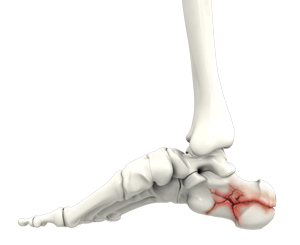
Foot fracture is a condition where there are small cracks in the bones. It occurs because of a fall, motor vehicle accident, dropping a heavy object on your foot or from overuse with sports. The trauma or repeated stress on the foot often results in pain, swelling, deformity and inability to bear weight.
What is a Foot Fracture?
A foot fracture is a condition where there are small cracks in the bones of the foot. It typically occurs as a result of trauma, such as a fall, a motor vehicle accident, or dropping a heavy object on your foot, but it may also be caused from overuse such as with sports.. Extreme force is required to fracture the bones in the hindfoot.
What is the Normal Anatomy of the foot?
The foot has 26 bones that can be classified into 3 sections:
- The hindfoot is comprised of two bones: the talus bone that forms the bottom portion of the ankle joint and the calcaneus bone that forms the heel.
- The midfoot is comprised of the navicular, the cuboid and three cuneiform bones.
- The forefoot is made up of five metatarsal bones and 14 toe bones called phalanges.
Muscles, tendons, and ligaments support the bones and joints of the feet, enabling them to withstand the entire weight of the body while walking, running and jumping.
What are the Types of Foot Fractures?
Foot fractures can involve different bones and joints, and are classified into several types:
- Calcaneus fractures: This affects the heel bone and occurs mostly as a result of a fall from a height or high-energy collisions. These can be disabling injuries.
- Talus fractures: The talus bone helps to transfer weight and forces across the ankle joint and hindfoot. Talus fractures usually occur at the neck or mid portion of the talus.
- Navicular fractures: Navicular fractures are rare and most often include stress fractures that occur with sports activities such as running and gymnastics because of repeated loading on the foot.
- Lisfranc fractures: This type of fracture occurs most commonly due to high energy trauma to the foot. It may also occur due to excessive loading on the foot, which leads to stretching or tearing of the midfoot ligaments.
What are the Common Causes of Foot Fractures?
Foot fractures commonly occur because of a fall, motor vehicle accident, dropping a heavy object on your foot or from overuse such as with sports.
What are the Symptoms of Foot Fractures?
The common symptoms of a foot fracture include pain, bruising, tenderness, swelling, deformity, and inability to bear weight.
How are Foot Fractures Diagnosed?
Your doctor diagnoses a foot fracture by reviewing your medical history and performing a thorough physical examination of your foot. Imaging tests such as X-rays, MRI or CT scans may be ordered to confirm the diagnosis. Navicular fractures can be especially difficult to diagnose without imaging tests.
What is the Treatment for Foot Fractures?
The treatment for foot fractures depends on the type of fracture sustained. For mild fractures, non-surgical treatment is advised and includes rest, ice, compression and elevation of the foot. Your doctor may suggest a boot, splint or cast to immobilize the foot. For more severe fractures, surgery may be required to align, reconstruct or fuse the joints. Bone fragments may be held together with plates and screws.
Physical therapy may be recommended to improve range of motion and strengthen the foot muscles. Weight-bearing will be determined by your doctor should be a gradual process with the help of a cane or walking boot.





